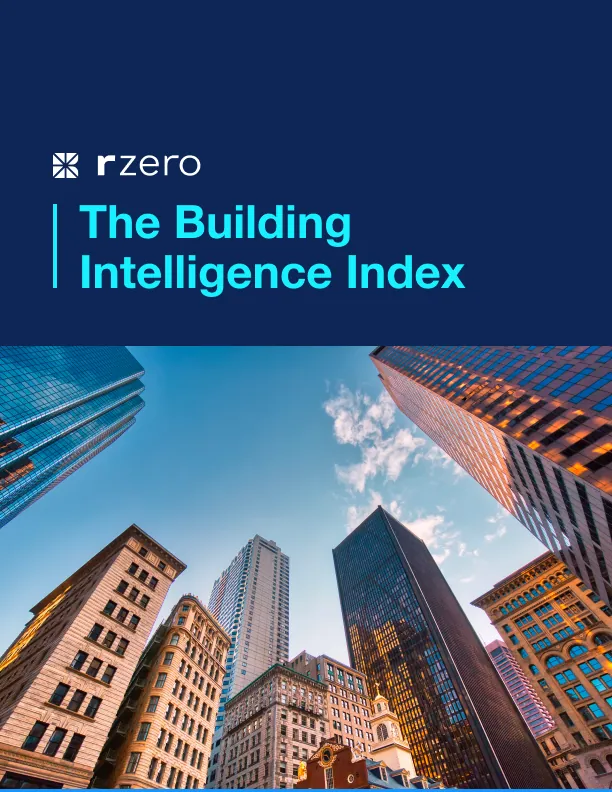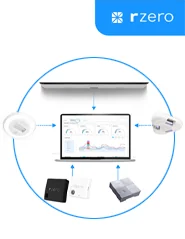
Smarter ventilation, fewer headaches: how R-Zero’s O-DCV pilot works—and why it pays off
If you’re exploring an energy savings pilot with R-Zero, here’s what your teams need to know: how it works, what’s involved, how it compares to traditional systems, and how it creates value for asset, operations, and facilities leaders — fast and without disruption.
First, what is O-DCV?
Occupancy-Driven Demand Control Ventilation (O-DCV) uses real-time occupancy data to automatically adjust HVAC settings, so you’re ventilating spaces only when and where people are present. This is a major upgrade from static schedules or slow-reacting CO₂ sensors.
With R-Zero, it’s more than just occupancy. We combine real-time people count with electrically enhanced filtration to deliver a more intelligent, more efficient system that reduces energy waste, improves comfort, and cuts maintenance workload.
How it works
R-Zero’s platform connects discreet, AI-enhanced sensors to your existing BMS via BACnet/IP. That means:
- Live occupancy data determines when and where to ventilate
- Fan speeds and airflow are automatically adjusted in real time
- High-efficiency filters reduce pressure drop, extending filter life and saving fan energy
- All data stays on-prem unless analytics are explicitly requested
🧭 For asset & ops teams:
Don’t waste energy conditioning empty space.
Separately, understand actual usage by suite or zone, and use that data to guide leasing, renewals, and OpEx decisions.
⚙️ For ops & facilities:
Less runtime reduces wear on HVAC systems.
Separately, fewer comfort complaints and longer-lasting filters lighten the day-to-day workload for facilities teams.
The pilot process
We tailor each pilot to your building’s unique needs—but every pilot follows a streamlined, low-friction path to measurable results.
Step-by-step:
- Discovery & scoping
- Identify target zones with energy or utilization upside. These are typically areas of your building with less than full occupancy Monday – Friday
- Review mechanical drawings, BMS setup, filter types
- Set goals: energy savings, utilization insights, IAQ comfort
- Site survey & design
- Virtual or in-person walkthrough
- Map occupancy zones to HVAC systems
- Scope occupancy sensor layout + filter upgrades
- Deployment & integration
- Install sensors + a gateway (no construction, can take place after hours) to share data to BACnet
- Ensure BMS can read the data from BACnet
- Swap in R-Zero filters—drop-in replacements with higher efficiency and lower pressure drop
- Monitoring & optimization
- Live data begins informing HVAC adjustments
- Fan energy, outside air, and/or heating and cooling load drop in underused zones
- Filter performance (pressure drop, fan energy) tracked over time
- BMS data is reported back to R-Zero for measurement weekly or monthly by email of BMS trend data or via direct API connection
- Cloud occupancy analytics turned on
- Review & expansion planning
- Summarize results: energy saved, filter life extended, zone utilization logged
- Plan phased rollout to more zones or buildings
- Share findings with internal stakeholders
🛠️ “The install took less than a day. Our BMS picked up the data immediately, and within two weeks, we saw fan power drop 25%.”
— Director of Engineering, Commercial RE Portfolio
Why R-Zero’s approach beats traditional HVAC and DCV
| Capability | Scheduled HVAC (Static) | Traditional DCV (CO₂-Based) | R-Zero O-DCV + Filtration |
| Control logic | Fixed time-of-day schedules | Reactive to CO₂ levels | Real-time people count |
| Zone precision | Whole building or floors | Suite-/zone-level control | Suite-/zone-level control |
| Energy impact | High runtime, high waste | Moderate savings, but runs after rooms are empty due to lingering CO₂ | Up to 30% HVAC savings with immediate response when rooms empty |
| Filter impact | No impact | No impact | Filters cut fan energy & swaps |
| Comfort data | None | None | Optional live IAQ monitoring |
| Maintenance | High due to overuse | Still reactive | Less runtime, longer filter life |
| Comfort impact | Over-conditioning or complaints ignored | Delayed response: discomfort during meetings, higher risk of complaints | Immediate response: comfortable air as people enter, fewer hot/cold calls |
“With R-Zero, we’re not just ventilating smarter—we’re buying time on major HVAC replacements. And I’m not chasing filter orders every 6 weeks anymore.”
— VP of Operations, National Portfolio
What you get
🧱 Asset managers
- Lower operating costs from HVAC savings
- Utilization insights at the suite level identify lease risks and growth patterns
- No capital or operating budget impact, thanks to our shared savings model
- Clear data to support capital planning and leasing strategy
⚙️ VPs of operations
- Direct energy savings against your budget from reduced HVAC power and reduced runtime
- Fewer filter swaps = lower material and labor cost
- Longer HVAC equipment lifespan via reduced runtime and load
- Lower risk of comfort complaints, higher operational reliability
🛠️ Facilities teams
- Less runtime, fewer calls, and real-time visibility
- Filters that last 2–3x longer, with lower pressure drop
- Simple install with no IT or construction headaches
- Live data helps spot IAQ issues before you get complaints
Why proceed
- Fast installs, measurable impact in weeks
- No cost to start, no disruption to tenants
- Energy + maintenance savings from day one
- Cross-functional value for asset, ops, and facilities leaders
📩 Ready to align internally or scope your pilot? We’re here to support that conversation—and deliver data that makes the case for you.
More posts you might like
-

How to Pilot SecureAire Filters
A Step-by-Step Guide for Facilities Teams Cut HVAC energy use, extend filter life, and improve indoor air quality—without disrupting operations. Piloting R-Zero’s SecureAire filters is a smart move for facilities teams seeking to enhance HVAC performance and air quality while achieving energy savings. This guide walks you through how to plan and execute a data-driven […]
-

Smarter ventilation, lower cost: a guide to reducing HVAC energy without disruption
This guide is for energy leads and operations teams evaluating R-Zero. It outlines how our platform delivers measurable HVAC energy savings—not through expensive capital upgrades or disruptive equipment replacements, but by intelligently reducing airflow where it’s not needed and improving the efficiency of air movement through smarter filtration. Static schedules vs CO₂ vs occupancy-driven control […]
-

The Energy Efficiency FAQ: Clear Answers to Common Questions About Smarter Buildings
When people first learn about R-Zero’s platform, they often have smart, valid questions, and a few common concerns. Some are based on past experiences with other systems. Others come from how building operations used to work. This FAQ is here to give you clear, straightforward answers. Just helpful context on how R-Zero fits into your […]

